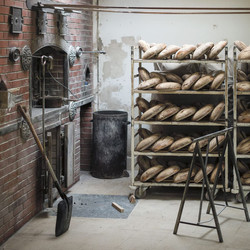Put the currants in a medium bowl, add the hot water, and let soak for 10 minutes. Set a fine-mesh sieve over a bowl and drain the currants; reserve the soaking liquid.
Pat the currants dry with a paper towel and reserve. Put the starter in a large bowl. Add the rye flour and yeast. In a small bowl, combine 1½ cups (355 ml) of the reserved soaking liquid (save the rest for brushing the loaf) and the salt, stir to dissolve the salt, and add to the flour mixture, along with the currants. With wet hands, mix and knead the dough in the bowl until it comes together in a smooth, homogeneous mass. Transfer the dough to a work surface and shape into a ball. Return it to the bowl and let rest for 15 minutes.
Reshape the dough into a round, return to the bowl, cover with a cloth, and let rise for 1½ hours.
Brush a 9-by-5-inch (23-by-13-cm) pan with oil. Turn the dough out and, using wet hands to prevent sticking, shape it into a 9-by-4-inch (23-by-10-cm) log. Transfer to the oiled pan. Brush a piece of plastic wrap with oil, drape it over the loaf, and let it rise in a warm (72°F to 77°F/22°C to 25°C), draft-free place until it rises about ½ inch (1.25 cm) above the sides of the pan, 1½ to 2 hours.
Meanwhile, about 25 minutes before baking, position a rack in the lower third and preheat the oven to 450°F (230°C).
Use a pastry brush to brush the top of the loaf with the reserved currant-soaking liquid. Bake until the loaf is golden and firm, 45 to 50 minutes; if you carefully remove it from the pan, it should feel hollow when you knock on it. Transfer the pan to a wire rack and let cool for 1 hour.
Remove the loaf from the pan, return to the rack, and let cool completely before slicing. Stored in a paper bag or wrapped in linen at room temperature, the loaf will keep for up to 1 week.
